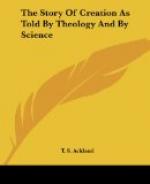But next, the variation in the insects and the flowers must take place at the same time and the same place, or no result will follow to the insect, while the new variety of orchid must perish for want of an insect to fertilize it. It is this which makes the supposition of unlimited time almost useless, because just in proportion as the time is increased the probability of two independent events happening simultaneously is diminished.
But even supposing this difficulty out of the way, we meet with an immediate repetition of it. The insect derives an advantage from its increased haustellum, but what advantage does the plant derive from its retiring nectary? How does that help it in the “struggle of life?” But if it produces no beneficial result, the variation according to the theory must drop. Hence we should arrive at an insect suited for a new form of the flower, but no flower suited to the new form of the insect.
If, then, we reject the idea of superintendence and design, we have on the one hand an enormous antecedent improbability, while on the other hand we have only a very small power by which a direction may be given to the course of events, since by the hypothesis in any one generation the change, and consequently the superior advantage, is exceedingly small, and there is a strong tendency in related changes, as in the case of the orchid and insect, to move in opposite directions.
But next, in the varieties of animals with which we are acquainted, there is a certain connexion between the differences of independent organs, for which this theory does not help us to account. Thus, for instance, according to this theory the canine and the feline races are descended from a common ancestor. But there are several points of difference between a cat and a dog. There are the differences in the form of jaws, in the dentition; in the muscles by which the jaws are moved, and in the feet and claws. All animals of the cat tribe agree in all these respects, so do all animals of the dog tribe. We never find a cat’s head combined with the feet of a dog. Why is this? Mr. Darwin attempts to account for it by his supposed law of “correlation of growth,” but, as has been already shown, any such law, being by Mr. Darwin’s definition the observed sequence of events and nothing more, is utterly useless, when it is brought forward as a cause for those events. On this point the theory completely breaks down.
3. The theory does not account for any changes which are not immediately beneficial. [Footnote: In the “Origin of Species” (Ed. 1872) Mr. Darwin makes an admission which is virtually a giving-up of his whole theory. He says, “In many other cases modifications are probably the direct result of the laws of variation or of growth, independently of any good having been thus gained; but even such structures have often, as we may feel assured, been subsequently taken advantage of,” pp. 165, 166. Here, then, we have a preparation for future circumstances,




